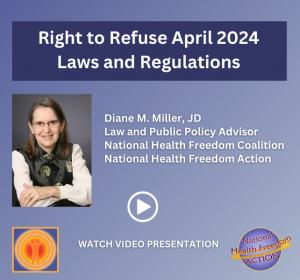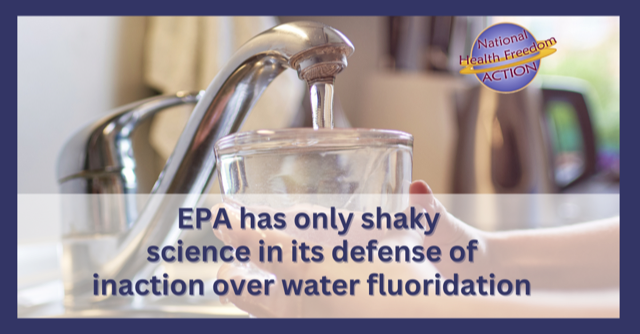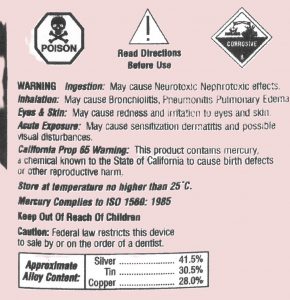

In the first part of the landmark trial against the EPA regarding the damage done from fluoride to children’s brains, the plaintiffs made their case through the testimony of their scientists. In our review of that part of the trial, we covered the plaintiffs, their competent, honest scientist expert witnesses, and he EPA’s failure to act in spite of the scientific evidence. The EPA’s response revealed tactics of obfuscation, poor scientific reasoning, and inappropriate use of basic math. But what else could the EPA do in the face of all the evidence world-wide showing harm? Their performance in this trial leaves us asking will the EPA protect us from any of the major toxins?
Risk assessment steps.
When the EPA assesses a possible environmental toxin, it uses the process of risk assessment. The first step is to establish that the substance poses a hazard based on high quality scientific studies. Then, actual levels of exposure are assessed. Third, the lowest adverse effect level is found; divide by a safety factor of at least ten to protect more vulnerable sections of the population, to arrive at a benchmark dose not to be exceeded. The actual exposure levels are compared with the benchmark dose and if exceeded, there is a risk. The EPA then assesses whether the level of exposure is an unreasonable risk. EPA’s judgment has to provide the answer. If water fluoridation is a hazard and a risk of harm to the brains of millions of American children, it would be difficult for the EPA to argue that water fluoridation is reasonable.
EPA’s strategy regarding risk assessment: deny that “hazard” has been established.
Plaintiffs’ experts established that many studies show hazard from fluoride levels at 1.5 or 2.0 mg/L (milligrams per liter). Other studies show a risk to public health with fluoride levels at 0.7 mg/L. The EPA’s strategy was clear from the outset: deny hazard. EPA had to dismiss all of the overwhelming evidence. Their tactic was to argue that there is uncertainty and inconsistency between the scientific studies thus leading to their conclusion that there is no firmly established hazard.
EPA’s final four.
To that end, EPA narrowed its focus down to a list of four studies and the evidence they provided about the impact of fluoride on the brains of children. Studies #1 and #2 showed hazard at low levels. Notably, two of the plaintiff’s expert witnesses were co-authors in those studies. Studies #3 and #4, on the other hand, did not show neurotoxic hazard. The EPA concluded: game over, we won, two studies against two studies, the science is too inconclusive; and the risk assessment process must be halted right there.
Why the EPA’s choice of Studies #3 and #4 was goofy.
Study #4 was done in Denmark which has never been fluoridated so the data cannot be expected to show a neurotoxic effect. Study #3 is the worst study that EPA could have chosen to include for several reasons. The first issue is the methodology used in the study, as it took place in the Basque region of Spain with the highest per capita seafood consumption in the world. The healthful fish oil content in seafood benefits child brain development, so the authors decided to correct for the benefits by providing a questionnaire about food consumption. Instead of using the results, they used measured mercury body burden as a proxy for seafood consumption. Mercury, which is a notorious neurotoxin cannot be a proxy for a brain benefit. Mercury is found in some seafood like larger fish. But in the Basque, such small fish as anchovies and sardines which are low in mercury are eaten at lunch time in high amounts. The study’s choice of mercury as a proxy for seafood was flawed. Consider also that there are also other major sources of mercury including dental mercury and thimerosal, used in some vaccines. Study #3 also had a bizarre conclusion: higher fluoride levels from water fluoridation caused a whopping 15-point IQ increase in boys. This implausible effect did not hold when the IQ results were compared with fluoride in the urine until after the authors “corrected” the data using creatinine. Creatinine corrections usually enhance existing effects but do not usually produce new effects. So, EPA’s inclusion of Study #4 seems to reflect a desire to support its preferred conclusions rather than good scientific judgment.
Near the trial’s end, EPA shifted its strategy demanding a simple dose-response math formula.
EPA gave the plaintiffs and the judge the following argument: the data showing a harmful effect doesn’t neatly fit onto a straight-line, so maybe the dose response curve is actually a quadratic formula or even a cubic formula. If the mathematical formula is unknown, EPA argued that the basic science of hazard for fluoride has not been clearly established.
Why EPA’s math demand is goofy.
To use math lingo, intelligence is a function of many variables, dozens of them and more, including nurturing variables like protein, healthy fats, vitamins, minerals, sunshine, exercise, and education, as well as harmful variables like mercury, lead, pesticides, and harmful EMFs. Intelligence can never be expressed as a polynomial function of dozens of variables. Intelligence cannot be a simple function of any one of those variables while the other variables are kept the same. A scientific study of intelligence and a variable that it depends on, like fluoride exposures, tries to determine whether that variable is detrimental to intelligence or not. If studies show that the variable is clearly detrimental, that is enough. Intelligence can never present as a simple math formula because the myriad other variables affect the measurement. A simple dose-response curve cannot exist.
The EPA kept complaining that urinary fluoride concentrations are not the same as the concentration of fluoride in the drinking water, arguing a deficiency in the science.
EPA scolded the plaintiffs for producing studies that relied on urinary measures of fluoride – in the mom’s urine during pregnancy – rather than fluoride concentrations in the community’s water. The EPA’s attorney reminded the court that EPA does not regulate urinary fluoride levels just water fluoride levels. EPA used this as a criticism of most of the study evidence about fluoride’s neurotoxicity, since the studies most often used measurements of urinary fluoride. Ironically, EPA’s final four studies all used urinary fluoride measurements.
FACT: There is no precise ratio between urinary and water fluoride concentration and there need not be.
Studies often measure an individual woman’s urinary fluoride concentration because that is the best way to identify her individual fluoride exposure and the better way to assess the over-all fluoride exposure which affects the child’s IQ. Using urinary fluoride is better than recording water fluoride levels for the entire community. Urinary fluoride reflects fluoride coming from all sources – food, beverages, environmental pollution, toothpastes and dental treatments. The amount of fluoride from other sources will always vary from time to time and place to place. So, of course, the ratio of water fluoride concentrations to total exposure will vary from study to study. EPA’s complaint about that variability is just foolish.
EPA’s psychological ploy: they are zealots in protecting public health.
When the Court expressed skepticism about EPA’s scientific arguments, EPA made a psychological ploy. EPA’s risk assessment chief, Stanley Barone, strayed from the topic of fluoride to point out their zealotry in their crackdown on ten toxic substances under the Toxic Substances Control Act (TSCA) including tetrachloroethylene, widely used in dry cleaning shops, as well as methylene chloride, used as a solvent in metal cleaning, sealants and degreasers. Michael Connett, the plaintiff’s lead attorney countered that EPA has been zealous in halting substances that harm hundreds or even thousands of workers in their occupational exposures. But when it comes to protecting the public from exposures that affect millions of Americans, the zealousness is gone. Fluoride in drinking water affects over 200 million Americans. Dental mercury, mercury in vaccines, GMO foods, insecticides, toxic EMFs as from cell towers, Wi-Fi and 5G affects hundreds of millions. (EPA expert David Savitz bragged how he helped EPA decide that the science is too uncertain to do anything about EMFs). EPA is not zealous in protecting the public from these meta-toxins. If the court rules against the EPA, fluoride will become a mega-poison that the EPA will not be able to ignore any longer.
By Leo Cashman
Co-Founder of National Health Freedom Action and National Health Freedom Coalition





